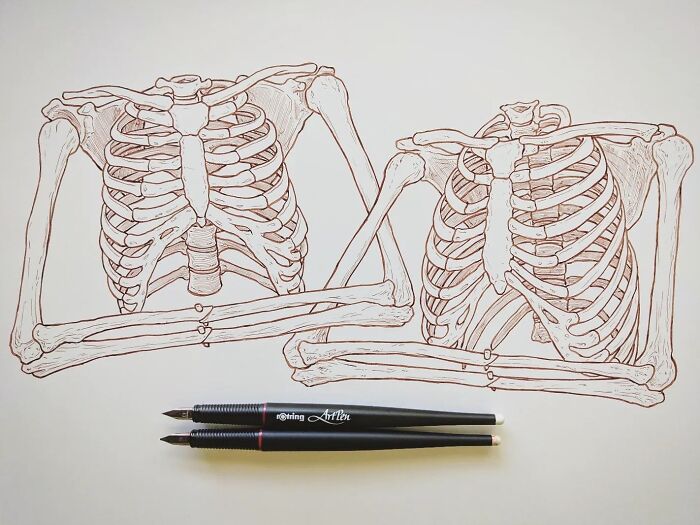It is nowhere near Halloween so view these drawings at your own risk cause they might give you unwanted nightmares.
Artist Ed Harrington, known as nothinghappenedtoday on Instagram, creates incredibly eerie drawings, some of which have even scarier stories behind them. However, despite their creepiness, we can't help but acknowledge the mastery of his artwork. So, here they are, Pandas. Let us know what you think about them in the comments below!
More info: Instagram | edharringtonillustration.com
This post may include affiliate links.
Cranial Osteocystis
"Colloquially known as "Bone Blisters". They are hollow, eggshell-like growths that form on the periosteum and corticol layers of bone. It isn't known why, but they only affect the skull. This is an extremely rare condition - the only suspected cases in the Western hemisphere being discovered in some of the unmarked graves of the 1607 Jamestown settlement. While the cause is unknown, it is currently theorized that prolonged consumption of drinking water with high levels of tannins along with a diet rich in purines paired with a calcium deficiency could lead to this condition. During the Middle Ages, physicians believed that a lifetime of collecting knowledge would cause these deformations of the skull - the condition only appeared in the elderly - and that the structures contained this excess information. Rarely, a fully formed sphere will detach from the cranium. These "pearls of wisdom" were often incorporated into memento mori in remembrance of the deceased (a suspected example of which can be found in the Bust of Charlemagne reliquary kept in the Aachen Cathedral Treasury in Germany). Cranial Osteocystis also had a lasting effect on the arts - these literal "thought bubbles" were depicted in etchings and drawings as a visual shorthand to represent thinking."
The Crag Barnacle
"Colloquially called "Witch's Horn" is a parasitic land arthropod related to the gooseneck barnacle that inhabits the forest floors of the Pacific Northwest. Unlike their aquatic cousins, they do not need a body of water to survive. Late 18th- and early 19th-century loggers would typically get an infestation from wearing damp or wet socks in an area teeming with the larvae. The remedy would be to coat the afflicted foot in oil until the parasite suffocates, then wait a few days for the attached surface layer of skin to naturally exfoliate, releasing the shell. Unscrupulous logging foremen who couldn't afford to have a worker off their feet and immobile would speed up the process by "holding their feet to the fire" - killing the parasite and neutralizing the cement gland at the same time - to the painful distress of the infected logger. Interesting side note: Due to the name, people wrongly assume that they live on rocky crags. In fact, they were named for their stoney appearance."
uh oh, i run around barefoot outside in a forest near my house.... i also hapen to live in the pacific north west
"This drawing is actually based on a dream I had years ago. In it, I was a girl in a private school with teeth growing out of both of my hands. My classmates would tease me by calling me "Chompers" and vertically smacking together these parts of their hands twice over and over. I always wanted to do something with the imagery, so here it is."
Dapper Cephalopod
"Interesting facts: The eye of a nautilus does not contain a lens, so they function much like a pinhole camera -- it is literally a hole filled with seawater. Also, the tentacles lack both hooks and suckers. Instead, they adhere to food and rocks using a kind of natural glue. Fascinating!"
Linguadontia
"It is the very rare condition of having supernumerary teeth growing out of the muscles and mucosa of the tongue. The last reported case was in 1932. It has been theorized that "America's First Serial Killer" H.H. Holmes suffered from the malady, due to rumored accounts of a faint clicking sound emanating from his mouth when he spoke. There is evidence of hereditary factors along with environmental factors leading to this affliction, although more study is needed. (It is suggested that supernumerary teeth develop from a third tooth bud migrating from the dental lamina near the regular tooth bud or possibly from splitting the regular tooth bud itself.) Many teeth never erupt, but lay embedded in the deep muscle tissue of the tongue under the mucosa. Dental fluoroscopy was used to diagnose these dormant linguadontia. While a single excess tooth was more likely to occur, multiple linguadontia was extremely rare in people with no other associated diseases or syndromes. Although these teeth are usually asymptomatic and pose no threat to the individual, they were often extracted for aesthetic reasons. Since the teeth are not anchored into a bony structure, removal was a rather simple procedure just requiring a few stitches to suture the resulting cavity."
A Woman With Her Giant Isopod
"The tongue-eating louse (cymothoa exigua) is a much smaller parasitic isopod that severs the blood vessels of a fish's tongue, causing the appendage to fall off. It then attaches itself to the remaining stub and effectively serves as the fish's new "tongue" until the fish dies."
Okay, but hear me out: normal isopods (roly-poly/pillbug) are cute as heck and make great pets! XD
Ossifixion
"It is a form of torture and capital punishment during the very early Medieval era (circa the late 5th century). So rare in fact, the only alleged records of the practice were depicted in a handful of tapestries from the years 1000-1200, and whether the images were a record of actual events or fictional depictions has been debated for years. The practice was reserved for a husband and wife who committed the worst crime at the time: plotting against the King. First, the hands were cut off and the flesh peeled back, exposing the radius and ulna. The bones were then mitered, drilled and pegged together with an ivory dowel, followed by stitching the flesh back together - linking the man and woman together arm in arm for the rest of their shortened lives. The length of time required to reach death could range from hours to days depending on method, the victim's health, and the environment. Blood loss, infection, sepsis, and even dehydration from the inability to carry water to the lips (plus any movement was excruciating) were the causes of expiration. For an additional punishment, food and water would be administered to the victims, ensuring that the couple not succumb too quickly from the procedure and spend "days enchained" (which was eventually shortened to the phrase "daisy chain" over the centuries). Since no physical evidence exists in the historical record, this illustration is an educated guess of what the skeletons may look like."
The Portuguese Goliath Snail (Gigantohalicocochlea)
"It is an extinct species of massive, air-breathing land snail that was endemic to the Iberian peninsula and northern Morocco. They weighed up to 120 kilograms and reached a length of 2 meters. While their docile nature and lumbering gliding speed made them well-suited as mounts for young children, it also made them easy targets for hunters. (Unbeknownst at the time, handling the snail can infect a child with the nematode cerebrostrongylus cantonensis, also known as "spiral brain worm," causing the deadly infection eosinophilic meningitis.) The snails were culled to extinction for their highly sought-after shells -- the iridescent, abalone-like interiors were used for jewelry, buttons, buckles, and decorative furniture inlays. A 55-centimeter Portuguese Goliath shell wash basin can be found inside one of the numerous lavatories at Buckingham Palace. The last snail in captivity died at the Manchester Zoological Gardens in 1841, although undocumented sightings of the Portuguese Goliath persisted well into the 1890s."
Wonder if this is the origin of all the weird drawings of people riding snails in medieval texts
Tetracaudates
"Also known as "Feowerwogs". They are a cryptid parasite that lives in and feeds on the proteins and sugars in the eye's vitreous humor (the clear gel-like substance that fills your eye and helps it keep its shape). They are so rare, little is known or speculated about them - including how they spread to humans. Before the modern era of medicine, symptoms of infestation were often ignored by physicians. The infected patients complained of seeing "dark phantoms" - it turns out that they were seeing the shadow cast from the organism hitting the retina. Instead of medical help, the patients were routinely misdiagnosed and treated for a psychiatric disorder (or even possession of witchcraft further back in our history). Interestingly, these parasites may debunk another cryptid phenomenon - sky serpents (elongated serpentine creatures that appear to float or fly in the air). It is theorized that what witnesses saw wasn't in the sky but was actually the undulating feowerwog larvae in their own eyeballs. Removal of the parasite involved cutting a semicircular sceleral flap which can be sutured after replenishing the eye with donor vitreous humor (usually from a cadaver). In severe cases, the only remedies are enucleation or evisceration of the eyeball."
"Taking The Pufferfish Out For A Stroll"
"Fun fact - they are the most poisonous fish in the sea and the second most poisonous vertebrate in the world. Swipe if you want to see the underlying pencils. Also, that blowfish's face might be my favorite thing I've drawn in a while - he is so happy!"
Trypophobia
Osseous Boletationis
it's a very dapper disembodied beaver skull, duh /j
Load More Replies...
 Dark Mode
Dark Mode 

 No fees, cancel anytime
No fees, cancel anytime 






















































